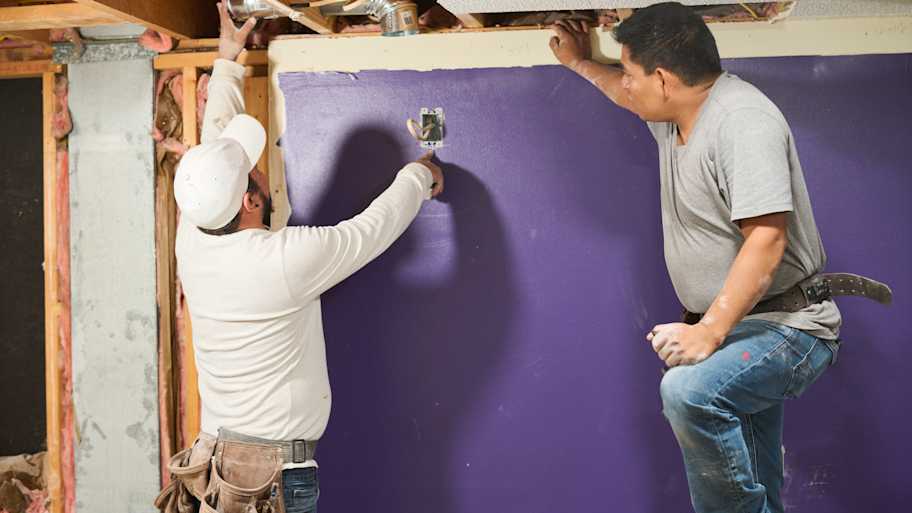How to Repair Cracks in Drywall Seams in 8 Steps
Put cracked drywall seams out of sight–and out of mind


- Utility knife
- Putty knife
- Drywall taping knife
- Joint compound pan
- Fine grit sandpaper
- Drywall tape (fiberglass mesh or paper)
- Premixed joint compound (drywall mud)
Contractors will tell you that applying and mudding drywall tape properly can feel more like fine artistry than construction work. Hiding drywall seams with mud and tape is a challenging job to do well. So when your drywall seam tape pulls loose or shows damage and you need to learn how to repair cracks in drywall seams, it can be a little intimidating. Fortunately, you can do the work as a DIY job with just a bit of patience and know-how—no art degree required.
Remove Damaged Drywall Tape and Mud
To start the process of how to repair cracks in drywall seams, you need to remove damaged material.
Use a utility knife to carefully cut the damaged drywall tape section out of the wall. Make the cut a few inches above and below the damaged section. Make a straight cut, which will simplify patching in the new piece of drywall tape later.
If necessary, use the knife blade to further loosen the tape so it pulls away without tearing any of the paper covering the sheet of drywall.
Use the utility knife or a putty knife to carefully scrape away any loose dried joint compound (also called drywall mud). You want to leave any solidly attached mud and tape in place if at all possible.
Fill the Drywall Seam Crack With Mud
 Photo: LUNAMARINA / iStock / Getty Images Plus / Getty Images
Photo: LUNAMARINA / iStock / Getty Images Plus / Getty ImagesWith the seam crack cleaned out and fully exposed, you now can fill it in with fresh joint compound. Add a very thin layer of mud across the entire section of drywall tape that you removed.
Because you’re only going to use a little bit of joint compound for this entire repair job, go ahead and purchase premixed compound, as it will only cost you a couple of extra dollars versus the hassle of mixing it yourself.
Add New Drywall Tape in the Area of the Seam Crack
 Photo: LUNAMARINA / iStock / Getty Images Plus / Getty Images
Photo: LUNAMARINA / iStock / Getty Images Plus / Getty ImagesImmediately cut a piece of drywall tape that is the same length as the piece you removed. Apply it to the section where you added the thin layer of drywall mud, taking care to line up the edges perfectly so there’s no overlap.
Use your putty knife to—very gently—smooth out the tape and press it into the wet mud. Do not leave wrinkles in the tape. It needs to be perfectly flat.
Then let everything dry. How long it will take the spackle to dry will depend on the humidity level and the thickness of the layer of the mud. Typically, a couple of hours should be long enough for a thin layer. If you used quite a bit of mud because of a large crack, though, let it dry overnight to ensure it’s completely dry.
Add Another Thin Layer of Drywall Mud Over the Tape
Using your drywall taping knife, carefully spread a layer of mud over the new section of tape. Use as little force as possible to avoid tearing the new tape. Drywall taping knives typically range from 3 or 4 inches to 10 or 12 inches wide. You may want a smaller, 6-inch knife for this step and a 12-inch knife for future steps.
Feather the mud a couple of inches wider and higher than the section of tape so the mud fully covers the visible edges.
Feathering involves holding the taping knife at an angle that allows you to scrape the excess mud away in a continuous stroke while spreading mud across the edges of the tape. Scrape gently from the center of the tape outward.
You want to leave a layer of mud on the tape thick enough to cover the edges adequately. However, the thinner the layer, the easier it is to sand later, saving you time. Making the layer the perfect thickness is a challenging aspect of this job. Allow it to dry.
Repeat Adding Another Thin Layer
 Photo: PrasongTakham / iStock / Getty Images Plus / Getty Images
Photo: PrasongTakham / iStock / Getty Images Plus / Getty ImagesAdd another layer of mud in the same area. It should be extremely thin again and should go a little wider and longer than the previous layer. Allow it to dry.
Sand any Bumpy Sections
Use your fine-grit sandpaper to sand out any areas of the dried mud that are bumpy or that seem uneven. Use a damp cloth to wipe away dust after you sand.
Apply a Final Thin Coat of Drywall Mud
 Photo: Mindklongdan / iStock / Getty Images Plus / Getty Images
Photo: Mindklongdan / iStock / Getty Images Plus / Getty ImagesUsing your wide drywall taping knife, add one final coat of mud over the area. Make it extremely thin. Allow it to dry.
Sand and Paint the Repaired Area
 Photo: GeorgePeters / E+ / Getty Images
Photo: GeorgePeters / E+ / Getty ImagesBy this point, it should be impossible to see the seams on the drywall tape. If you can still see seams, you may need to continue repeating steps six and seven—or it may be time to call in the professionals. Feathering drywall mud and hiding tape can be a challenging process that requires a lot of patience.
If the tape is completely hidden, use the sandpaper to smooth out the area one last time. Wipe away the dust. You can now paint the wall to finish the job.
DIY vs. Hiring a Pro
If you have the time and patience to repair cracks in the drywall seams yourself, you’ll save a lot of money. The average drywall repair cost is almost $600. However, drywall repair often involves fixing holes, which costs more than repairing the cracks in drywall seams, which typically costs $60 to $400.
One issue with this type of repair is the long drying time required. A local drywall repair company may need to make more than one trip to your home for the job, which will drive up the cost.
Still, because of the challenge of making a cracked drywall seam repair job look good, hiring a professional is always an option.
Frequently Asked Questions
If you see small, hairline cracks in your drywall, which is extremely rare, you can simply spread a little bit of joint compound over the top of the crack without the need for using tape. Occasionally, you may see this type of damage when learning how to patch a drywall ceiling, as hairline cracks may appear in the ceiling. If the crack is large enough that you can place a putty knife inside, use seam tape to cover the crack and add joint compound over the top.
If your home’s foundation shifts slightly over time, any seams in the drywall represent the weakest point in the wall, leading to cracks. If your home has significant changes in temperature and humidity, this can cause the drywall to swell and contract slightly, causing a crack at the weak point of the seam. If your drywall installer did a poor job securing the panels to the wall studs, this could cause a weak layout and cracks in the seams.
It’s always better to follow proven drywall repair tips and fix the seams that look bad. However, if you simply want to make them less noticeable until you have time to fix them, you can use paint. A darker color of paint makes bad drywall tape seams less noticeable than light-colored paint. Matte paint hides bad seams better than glossy paint does, too.















